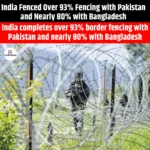India-Maldives Relationship
|
General Studies Paper II: Bilateral Groupings & Agreements, Groupings & Agreements Involving India and/or Affecting India’s Interests |
Why in News India-Maldives Relationship?
Recently, India and Maldives began talks on a new Free Trade Agreement (FTA) and investment treaty. Both the countries are exploring shared goals, with a focus on trade and clean energy. This discussion takes place just before Prime Minister Modi’s official trip to the Maldives.
Key Highlights of Prime Minister Modi’s Visit to the Maldives
- Prime Minister Narendra Modi is scheduled to visit the Maldives from July 25 to 26, 2025.
- Prime Minister Modi is scheduled to participate in the Maldives’ 60th Independence Day as the chief guest.
- During the visit, both nations have reopened dialogue on a Free Trade Agreement (FTA). This topic has been under discussion since May 2024, when the Maldives first expressed its interest.
- India is looking to support renewable energy initiatives in the Maldives. Solar power projects and sustainable technologies will likely be on the agenda.
- The visit could lead to more cultural, educational, and tourism exchanges between the two nations in the coming months.
Historical Foundation of India-Maldives Relations
- Support: India extended early diplomatic recognition to the Maldives when it gained independence on 26 July 1965. At that time, the Maldives ended its agreement with the British, who had maintained military bases in the islands. India extended immediate diplomatic support and helped the Maldives gain entry into the global community.
- Formal Establishment : Formal diplomatic relations between the two countries began soon after the Maldives’ independence. In 1972, India opened its High Commission in Malé, the capital of the Maldives.
- Operation Cactus: A major milestone in India-Maldives relations came in November 1988 during an attempted coup in the Maldives. The Maldivian government requested urgent help. India responded swiftly by launching Operation Cactus. Indian paratroopers were flown into Malé within hours, successfully restoring the elected government.
- Development: During the 1990s, India consistently provided development support to the Maldives.
- Assistance ranged from medical aid and education scholarships to capacity-building initiatives for Maldivian institutions.
-
- By the early 2000s, both countries had laid a stable foundation for a broader strategic relationship.
- The Indian Ocean tsunami in December 2004 caused massive destruction in the Maldives. Indian Navy ships and aircraft carried out rescue missions, supplied clean water, and rebuilding materials.
- As of 2024, over 25,000 Indian nationals are estimated to be living and working across various islands of the Maldives. A large number of them are employed in healthcare, education, construction, and hospitality sectors.
Also Read: India-Argentina Relations
Strategic Importance of Maldives in India’s Maritime Security
- Control Over International Sea Lanes: The Maldives sits near some of the busiest Sea Lanes of Communication (SLOCs) in the world. These sea lanes carry almost 80% of global oil shipments and over 60% of global trade. Indian oil imports and exports also depend heavily on these maritime passages. The Eight Degree Channel, which passes close to the northern Maldives, is particularly critical for India’s energy security.
- Geographical Advantage: The geographic spread of the Maldives across approximately 900 kilometers in the Indian Ocean offers India an extended maritime surveillance advantage. These islands serve as observation points for tracking ship movements, monitoring illegal fishing, and identifying threats such as piracy or trafficking. India has partnered with the Maldives in setting up coastal radar systems, which help cover blind spots in the Indian Navy’s coastal monitoring grid.
- Regional Stability: In recent years, India’s maritime strategy has focused not just on defense but also on preserving balance in the Indian Ocean Region (IOR). The presence of external powers, such as China, in South Asian maritime zones has become a concern for India. The Maldives, due to its central location, often becomes a point of interest for multiple global actors.
Economic Cooperation and Development between India and Maldives
- Trade Relations: Trade between India and the Maldives has seen consistent growth, especially in the last decade. India has consistently ranked among the Maldives’ most significant commercial partners. In 2023, bilateral trade crossed USD 300 million, highlighting increased commercial exchange.
-
-
- Essential Indian exports to the Maldives include food supplies, pharmaceutical products, refined fuel, and building materials.
- The Maldives sends goods such as seafood, recyclable metals, and small-scale agricultural products to the Indian market.
- The opening of the India-Maldives Cargo Ferry Service in 2020 marked a new chapter in logistics connectivity, directly linking Kochi and Kulhudhuffushi.
-
- Investments: India has played a growing role in the Maldives’ economic sectors, especially tourism, healthcare, and banking. Indian firms have invested in resort development projects, bringing expertise in eco-tourism and luxury hospitality.
-
-
- The State Bank of India has had an active presence in the Maldives since 1974 and operates through various local branches.
- India has extended a financial credit line of $800 million to the Maldives through the Export-Import Bank.
- To support the Maldivian economy during the pandemic, India offered a budgetary assistance loan of USD 250 million in 2021.
-
- Infrastructure Development: India has funded and implemented several high-impact community development projects across the atolls. India is backing the Greater Male Connectivity Project (GMCP) with a USD 100 million grant and a USD 400 million credit line, making it the Maldives’ largest infrastructure project to date. It aims to link Male with Villingili, Gulhifalhu, and Thilafushi via a 6.7 km bridge and causeway network.
- Skill Development: Thousands of Maldivian students have pursued higher education in Indian universities under the Indian Technical and Economic Cooperation (ITEC) and Indian Council for Cultural Relations (ICCR) programs.
- India also conducts training for Maldivian civil servants, engineers, and health professionals.
-
-
- To promote accessible education, India introduced a digital learning platform in 2022 for students in remote Maldivian islands.
-
- Tourism: In recent years, India has emerged as one of the top source countries for tourists visiting the Maldives. According to official tourism data from 2023, India ranked second after Russia in terms of tourist arrivals. In 2023, India secured the second position with 209,198 arrivals, while Russia topped the list with 209,146 arrivals.
Also Read: India-EU Trade Relations
Defense and Security Partnership between India and Maldives
- Joint Naval Exercises: India and the Maldives have carried out multiple joint naval exercises to improve operational coordination and strengthen maritime security. One of the major recurring drills is “Exercise Ekatha”, which focuses on coast guard training and interoperability.
-
-
- India and the Maldives conduct other regular military exercises, including “Ekuverin”, “Dosti”, and “Operation Shield”.
-
- In 2021, India’s naval ship INS Kesari visited the Maldives under Mission SAGAR, delivering medical supplies and conducting naval training.
- Capacity Building: Maldivian defense personnel have been receiving military training in Indian institutions for several years. Under bilateral defense ties, Maldivian officers have received formal training at Indian institutions such as the Indian Military Academy and Officers Training Academy.
-
-
- India has gifted a landing assault vessel and a fleet of 24 utility vehicles to Maldives.
-
- Defense Infrastructure: India has also contributed to the improvement of Maldivian defense infrastructure by helping construct facilities and donating key equipment. One of the landmark projects is the Coast Guard Harbour at Sifvaru, Uthuru Thilafalhu, which India agreed to build under a defense agreement signed in 2021.
- Strategic Agreements: The Defense Cooperation Agreement signed in 2016 laid the framework for regular dialogue, joint training, and equipment transfer. High-level defense meetings, such as the India-Maldives Defence Cooperation Dialogue, take place regularly to review progress and plan future engagement.
Challenges and Diplomatic Tensions in India-Maldives Relations
- Changing Political Leadership: One of the most visible shifts occurred after President Mohamed Muizzu took office in 2023. During his campaign, he strongly emphasized a policy of “India Out”, signaling discomfort with foreign military presence. This marked a departure from the previous government under President Ibrahim Solih, who maintained close ties with New Delhi.
- Troop Withdrawal Demands: Indian soldiers had been stationed in the Maldives to operate and maintain aviation platforms gifted by India, including two helicopters and a Dornier aircraft. In early 2024, President Muizzu’s administration formally requested India to withdraw its military personnel.
- Social Media Controversy: In January 2024, diplomatic strains rose after Maldivian junior ministers made offensive remarks about India’s Prime Minister, prompting many Indians to call for a tourism boycott, deeply impacting public emotions. The controversy forced the Maldivian government to suspend the officials involved, but the damage to public perception was noticeable.
- Shifting Alliances: In 2014, the Maldives signed an agreement with China under the Belt and Road Initiative (BRI). Since then, Chinese investment in infrastructure projects, such as bridges and housing, has increased. In 2024, a Free Trade Agreement (FTA) with China came into effect, signaling a deeper economic partnership. Indian view this growing proximity as a potential challenge to India’s strategic influence in the Indian Ocean.
The Way Ahead
- Prioritizing Inclusive Economic Growth: Infrastructure and investment projects should focus not just on scale but on local needs, job creation, and environmental care. Projects like the Greater Malé Connectivity Project, which is expected to be completed by 2026, must ensure local participation in construction, operation, and benefit-sharing.
- Strengthening People-Centric Diplomacy: India should expand educational scholarships, medical outreach, and cultural exchange programs to reach more citizens in the atolls. The Maldives can also encourage its students to explore learning opportunities in India’s educational hubs.
- Enhancing Maritime Security: To maintain stability, India and the Maldives must upgrade their maritime cooperation as equal and sovereign partners. Future collaboration should prioritize joint patrols, technical training, and radar data sharing without the presence of permanent foreign troops. Both sides can conduct regular bilateral defense reviews to address evolving needs.
- Balancing Strategic Interests: India’s strength lies in its democratic values, transparent aid structure, and regional familiarity. Regional platforms such as IORA (Indian Ocean Rim Association) and BIMSTEC can be used to align India-Maldives goals on climate action, disaster management, and trade.









